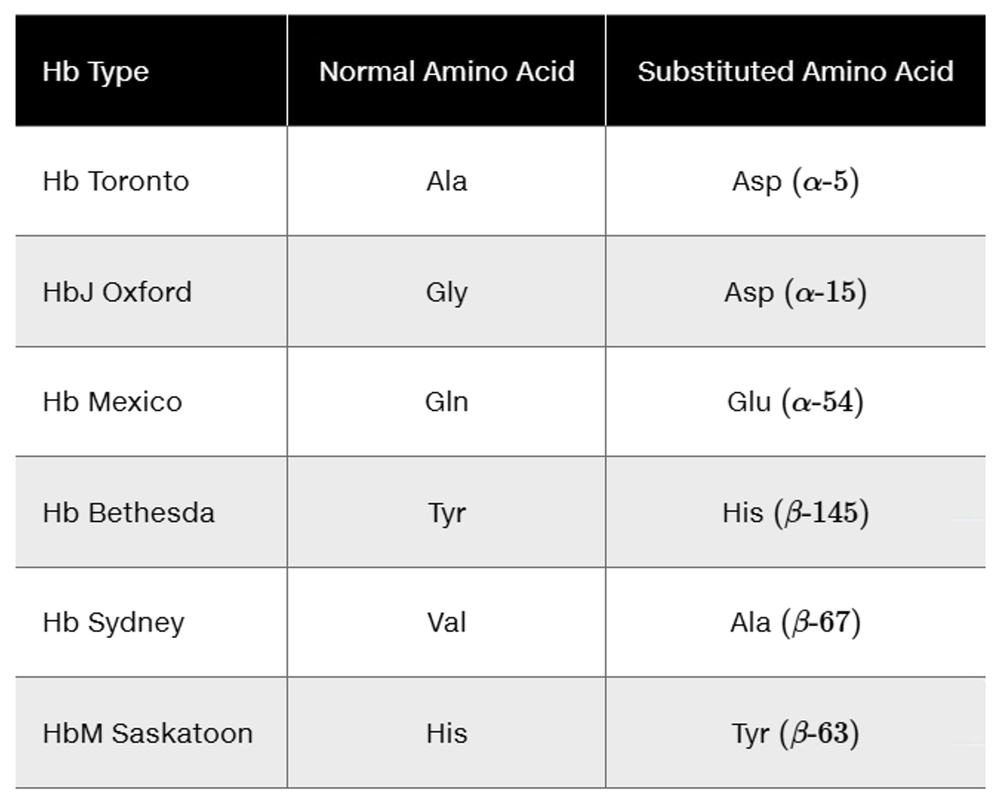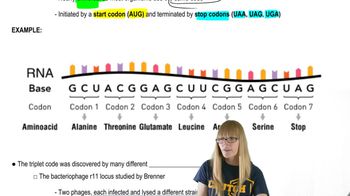Table of contents
- 1. Introduction to Genetics51m
- 2. Mendel's Laws of Inheritance3h 37m
- 3. Extensions to Mendelian Inheritance2h 41m
- 4. Genetic Mapping and Linkage2h 28m
- 5. Genetics of Bacteria and Viruses1h 21m
- 6. Chromosomal Variation1h 48m
- 7. DNA and Chromosome Structure56m
- 8. DNA Replication1h 10m
- 9. Mitosis and Meiosis1h 34m
- 10. Transcription1h 0m
- 11. Translation58m
- 12. Gene Regulation in Prokaryotes1h 19m
- 13. Gene Regulation in Eukaryotes44m
- 14. Genetic Control of Development44m
- 15. Genomes and Genomics1h 50m
- 16. Transposable Elements47m
- 17. Mutation, Repair, and Recombination1h 6m
- 18. Molecular Genetic Tools19m
- 19. Cancer Genetics29m
- 20. Quantitative Genetics1h 26m
- 21. Population Genetics50m
- 22. Evolutionary Genetics29m
11. Translation
Proteins
Problem 23
Textbook Question
Several amino acid substitutions in the α and β chains of human hemoglobin are shown in the following table.

Using the code table, determine how many of them can occur as a result of a single-nucleotide change.
 Verified step by step guidance
Verified step by step guidance1
Step 1: Identify the codons for the normal and substituted amino acids using the standard genetic code table. For each amino acid, write down all possible codons that encode it.
Step 2: For each hemoglobin variant, compare the codons of the normal amino acid with those of the substituted amino acid to determine if a single-nucleotide change can convert one codon into another.
Step 3: To check for a single-nucleotide change, examine each codon pair and count the number of nucleotide differences. If exactly one nucleotide differs, this substitution can occur by a single-nucleotide mutation.
Step 4: Repeat this process for all the hemoglobin variants listed in the table, keeping track of which substitutions are possible by a single-nucleotide change.
Step 5: Sum the number of substitutions that can occur by a single-nucleotide change to answer the question.
 Verified video answer for a similar problem:
Verified video answer for a similar problem:This video solution was recommended by our tutors as helpful for the problem above
Video duration:
4mPlay a video:
Was this helpful?
Key Concepts
Here are the essential concepts you must grasp in order to answer the question correctly.
Genetic Code and Codon Structure
The genetic code consists of nucleotide triplets called codons, each coding for a specific amino acid. Understanding how codons translate into amino acids is essential to determine how nucleotide changes affect protein sequences. Single-nucleotide changes can alter codons, potentially changing the encoded amino acid.
Recommended video:
Guided course

The Genetic Code
Missense Mutations and Single-Nucleotide Substitutions
A missense mutation is a single-nucleotide substitution that results in a different amino acid in the protein. Determining if an amino acid substitution can arise from a single-nucleotide change requires comparing codons of the original and substituted amino acids to see if they differ by only one base.
Recommended video:
Guided course

Point Mutations
Hemoglobin Structure and Variants
Hemoglobin is composed of α and β chains, each with specific amino acid sequences. Variants arise from amino acid substitutions in these chains, which can affect function. Identifying which substitutions result from single-nucleotide changes helps understand mutation mechanisms and their impact on hemoglobin.
Recommended video:
Guided course

Chromosome Structure
Related Videos
Related Practice
Textbook Question
Using sickle-cell anemia as an example, describe what is meant by a molecular or genetic disease. What are the similarities and dissimilarities between this type of a disorder and a disease caused by an invading microorganism?
637
views


